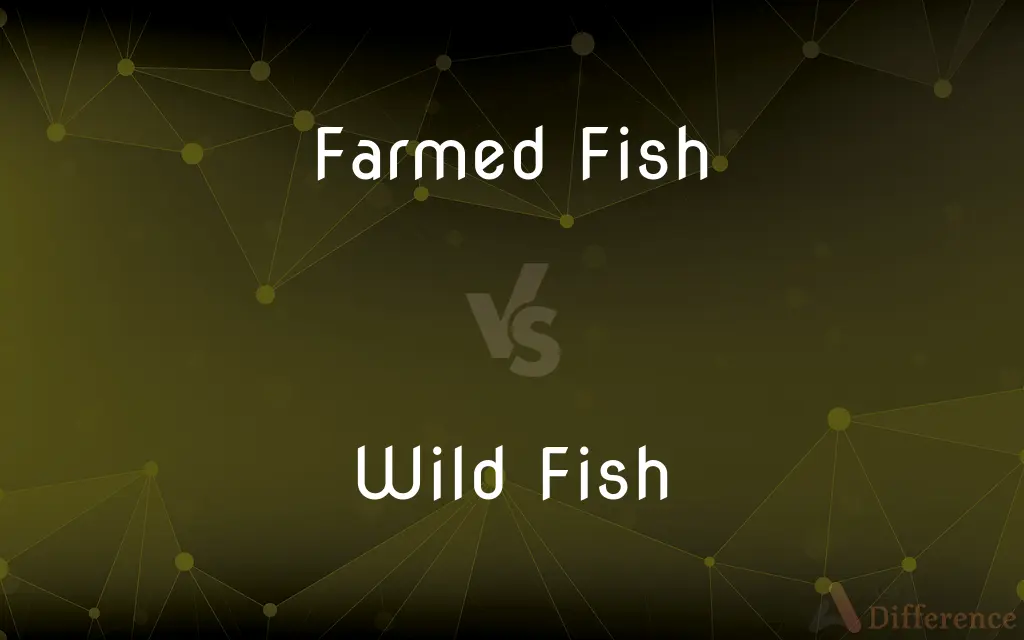Farmed Fish vs. Wild Fish — What's the Difference?
By Fiza Rafique & Maham Liaqat — Published on December 24, 2024
Farmed fish are raised in controlled aquatic environments for consumption, leading to differences in diet and lifestyle compared to wild fish, which live freely and have natural diets, resulting in variations in taste, texture, and nutritional content.

Difference Between Farmed Fish and Wild Fish
Table of Contents
ADVERTISEMENT
Key Differences
Farmed fish, cultivated in aquaculture operations, are provided with a controlled diet, intended to promote rapid growth and high yield. This controlled environment allows for year-round production but can lead to denser populations that may increase the risk of disease and require antibiotics or other treatments. In contrast, wild fish thrive in their natural habitats, feeding on a diet that contributes to their species-specific flavor profiles and nutritional makeup. The freedom to roam and natural diet results in a leaner physique with potentially higher levels of omega-3 fatty acids, depending on the species and environment.
The impact on sustainability is a significant point of difference. Aquaculture, when practiced responsibly, has the potential to alleviate pressure on wild fish populations, providing a renewable source of fish as demand continues to rise. However, concerns about pollution, antibiotic use, and the escape of farmed fish into the wild, potentially threatening native populations with diseases and genetic dilution, remain. Wild fish, considered more sustainable by some, face pressures from overfishing, habitat destruction, and climate change, which threaten their populations and the ecosystems they inhabit.
Nutritional differences between farmed and wild fish can be notable. Farmed fish may have higher fat content due to less activity and different diets, which can also affect the taste and texture, making them milder and more uniform than their wild counterparts. Wild fish, consuming a natural diet, often offer a more pronounced flavor, which can vary significantly by species and habitat. The nutritional content, including levels of omega-3 fatty acids, vitamins, and minerals, can also differ, with wild fish generally perceived as the healthier option.
Economic considerations also play a role in the farmed vs. wild debate. Aquaculture provides a consistent, year-round supply of fish, potentially at a lower cost due to controlled production methods. This accessibility and affordability can make seafood more available to a broader audience. However, the premium placed on wild-caught fish, prized for their taste and perceived health benefits, reflects in their higher market price, driven by the challenges of seasonal availability and the costs associated with sustainable fishing practices.
Both farmed and wild fish have their advantages and drawbacks, with choices often influenced by environmental, nutritional, and economic factors. Consumers seeking sustainable options may look for certifications and labels indicating responsible farming practices or sustainable wild fisheries, helping to ensure their seafood choices support healthy oceans and fish populations.
ADVERTISEMENT
Comparison Chart
Environment
Controlled aquatic environments
Natural habitats
Diet
Controlled, may include antibiotics
Natural diet
Sustainability
Can be sustainable, concerns about pollution
Pressures from overfishing, more sustainable
Nutritional Content
Higher fat content, variable omega-3 levels
Leaner, potentially higher omega-3s
Taste & Texture
Milder flavor, more uniform texture
More pronounced flavor, varied texture
Economic Impact
More accessible, potentially lower cost
Higher market price, seasonal availability
Health Risks
Risk of disease, antibiotic use
Lower risk of disease, no antibiotics
Omega-3 Fatty Acids
Depends on diet, often lower than wild
Generally higher, depends on species and diet
Environmental Impact
Potential for pollution, genetic dilution
Overfishing, habitat destruction concerns
Market Availability
Year-round
Seasonal, depending on species and regulations
Compare with Definitions
Farmed Fish
Health and environmental concerns have prompted improvements in farming practices.
New aquaculture technologies reduce disease and pollution risks.
Wild Fish
Wild fish often have a varied diet, affecting their nutritional content.
The diet of wild fish leads to higher omega-3 fatty acid levels in their flesh.
Farmed Fish
Farmed fish diets can be supplemented to enhance growth and color.
Farmed salmon are often fed astaxanthin to give their flesh a pink hue.
Wild Fish
Conservation efforts aim to protect wild fish habitats.
Marine protected areas are established to support the recovery of wild fish populations.
Farmed Fish
Sustainability practices vary widely in aquaculture.
Eco-certified farmed fish are produced with minimal environmental impact.
Wild Fish
Overfishing of wild populations has raised sustainability concerns.
Strict quotas are in place to protect wild cod stocks from depletion.
Farmed Fish
Farmed fish can be more affordable than wild counterparts.
Farmed tilapia offers a cost-effective alternative to wild varieties.
Wild Fish
Seasonal availability affects the market price of wild fish.
Prices for wild-caught fish can fluctuate based on the fishing season.
Farmed Fish
Farmed fish are raised in controlled environments to increase efficiency and yield.
Salmon farming has become a significant industry, providing a steady supply of fish.
Wild Fish
Wild fish live in their natural environments, contributing to their distinct flavors.
Wild-caught Alaskan salmon is prized for its rich taste.
Common Curiosities
Can farmed fish affect wild populations?
Yes, farmed fish can affect wild populations through escapees that compete with or breed with wild fish, potentially spreading diseases and affecting genetic diversity.
Why do farmed and wild fish taste different?
The taste difference is primarily due to the fish's diet and activity level, with wild fish often having a more pronounced flavor from their varied, natural diet.
How can consumers make sustainable seafood choices?
Look for certifications and labels indicating sustainable practices, such as MSC for wild-caught fish and ASC for farmed fish, to support environmentally responsible seafood choices.
What factors contribute to the higher cost of wild fish?
The higher cost of wild fish is often due to the expenses related to sustainable fishing practices, seasonal availability, and the premium placed on their natural diet and flavor.
Which is healthier, farmed or wild fish?
Wild fish are often considered healthier due to their natural diet and higher levels of omega-3 fatty acids, though this can vary by species and environmental factors.
Is farmed fish sustainable?
Farmed fish can be sustainable when practices minimize environmental impact, pollution, and disease, but standards vary globally.
Do all farmed fish contain antibiotics?
Not all farmed fish are treated with antibiotics; practices vary, and some farms use strict protocols to minimize or eliminate antibiotic use.
What are the economic benefits of aquaculture?
Aquaculture provides a consistent supply of seafood, contributing to food security and economic stability in many regions, and can be more accessible and affordable.
Are there environmental benefits to eating wild fish?
Eating wild fish can support sustainable fishing practices that maintain healthy fish populations and ecosystems, provided that these fisheries are well-managed.
How do farming practices impact the nutritional content of fish?
Farming practices, including the fish's diet and living conditions, can impact the nutritional content, such as fat levels and omega-3 fatty acids, making some farmed fish less nutritious than their wild counterparts.
Share Your Discovery

Previous Comparison
Referendum vs. Elections
Next Comparison
Aqueous Humor vs. Vitreous HumorAuthor Spotlight
Written by
Fiza RafiqueFiza Rafique is a skilled content writer at AskDifference.com, where she meticulously refines and enhances written pieces. Drawing from her vast editorial expertise, Fiza ensures clarity, accuracy, and precision in every article. Passionate about language, she continually seeks to elevate the quality of content for readers worldwide.
Co-written by
Maham Liaqat










































